Abstract
On a global level, there is an intensely growing interest for Computer Science graduates on the job market. Apparently, the EU expectation of a high ratio of degree-holders among residents attempts to provide solution to this problem as well. Capitation schemes make financing of schools dependent upon the number of students. So, codependency emerges between the students and the school. Students with below-average abilities massively appear on higher and higher levels of education. Expectations are unrealistically high in vocational schools, for instance, while the students artificially kept at school pull down the education standards. The result is an unmanageably high number of students, the crisis of the efficacy of education, catastrophic dropout and failure rates. Computer science education is in an especially hard situation, since the labor shortage is the highest in this field, but the profession needs specific skills and high level of knowledge. The consequences of erroneous education politics can be softened by innovative educational technologies. As an example, we will show two effective experience-based methods that motivated students on an adequate level, and that greatly improved the efficiency of studying. It greatly improved the active participation of students, and managed to improve the willingness to study further.
Keywords: Educational technologiescapitation schemesmass educationinnovative educational technologiesdropoutmotivating
Introduction
Positions requiring a degree in computer science are on a steep rise on a global level. On the one hand, the field of computer science is expanding, on the other hand, other fields has more and more IT roles, requiring properly trained professionals ( Hüsing et al., 2013).
Training-issuing cannot properly keep up with such a grand labor-demand. A labor shortage of nearly 900 thousand has been forecast in this field in the EU27 by the end of the decade ( Karsten et al., 2014). As the figure shows, there is a significantly greater increase in the demand for skilled labor than the output of schools (Fig.
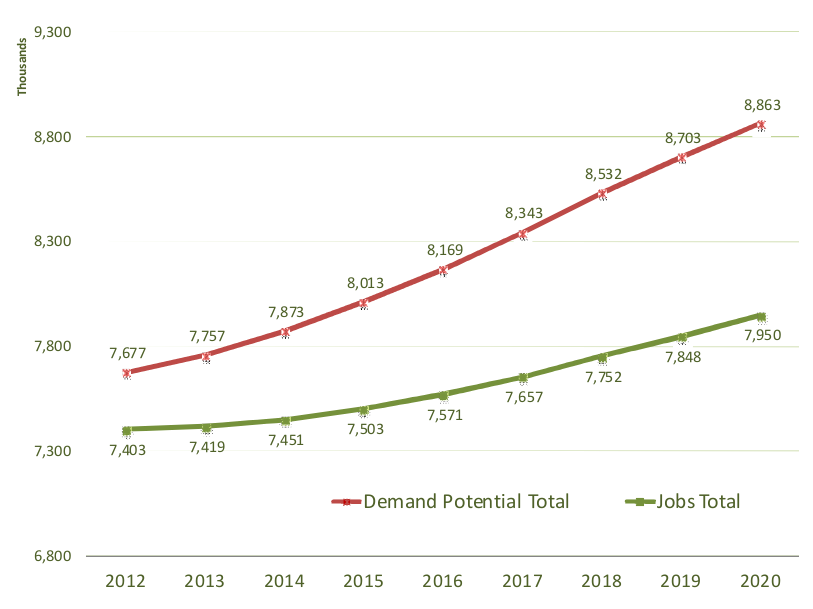
The pressure of providing the labor market with professionals is given, while graduates' subject knowledge stays on a certain level.
Graduates of higher-education institutions predominantly attended general secondary schools or vocational schools in a smaller percentage. Although the education of the trade itself starts earlier in trade schools, their lower standard of education leads to a significantly lower number of their graduates opting for higher education. So, many students first acquaint themselves with computer science on a higher level when they start their undergraduate studies. The issues of the two levels of education affect each other, so they can only be reasonably interpreted together.
The authors of the current article have the opportunity to actively participate in both secondary and higher education as a teacher. So we see the whole picture from the age of 14 through 21 – in case of undergraduate education – to predominantly the age of 23 in case of graduate education.
We can learn a lot about the changes of education policy and their consequences based on the Hungarian examples. When setting objectives of education policy is it worth considering these experiences as well. We aim to elaborate and present best practices to the emerging problems of education efficiency.
Problem Statement
The Crisis of Education Efficiency
Normative Funding
Hungarian schools before the regime change (1989) were characterized by strict discipline. The central, public funding was not dependent upon the number of students, and the currently experienced moral decay had not reached the students, thanks to the relatively closed system. Students did their best to stay in school, they worked hard and studied. Professionals having graduated from secondary or higher education were in possession of well-established knowledge if they were able to pass their final exams. Certificates and degrees had a value in the eyes of society.
The school funding system established after the regime change was based on the facts that although the type of service provided at schools or the salary given to teachers were ordered by the state, the education authorities – mostly the local governments – were responsible for all of them. Due to the varied income capacity of local governments, significant differences emerged owing to the expenses per student. Reductions between 2006 and 2010 led to several municipalities not being able to carry out their school-maintaining functions. Yet, school funding was not dependent upon the number of students. As a consequence, the school was not forced to keep its students at all costs. The school could still get rid of students that showed insufficient performance, or lack of interest in the profession, or that were unable to fit in without a problem. Consequently, students found it valuable to stay in school, and they spent time learning for it. Education was highly effective because students were interested in improving their grades. This time period and the preceding one were characterized by greater discipline and more effective education.
Since 2013, the previously normative funding was replaced by task funding (capitation scheme). It means that public educational institutions receive the salaries of pedagogues and school workers from the state. That is, all teachers get their salaries from the central budget from now on. Maintenance of buildings, acquiring educational equipment and other costs are covered by the educational authorities. Pedagogues' salaries are provided by the state in non-public schools as well – such as alternative, foundation or religious schools – but further funding is only available to those holding a public education agreement signed by the Education Minister.
Since 2013, the public educational authority is Klebelsberg Institution Maintenance Center (KLIK) under public education law, then vocational schools became parts of various vocational education centers. Management was carried out along with professional centralization. The role of the state became more dominant in appointment of school leaders, creation of framework curricula, control of pedagogues, regulation of content and distribution of textbooks. The aim of the government is unification, so that each child could possibly get the same conditions in every public school.
The byproduct of change is that the funding and the budget of schools are determined by the number of students. University majors, or even schools without enough students are abolished. The situation is the same in higher education, where less popular majors are not stable, as they get lower funding. More popular majors, like Computer Science has greater financial stability. So in both secondary and higher education, it is essential to keep a certain number of students. In less popular institutions it is done at all costs, even if the standard of education declines. Both students and parents are aware of this dilemma. The significance of good grades is devalued. They even know that minimal performance is enough to stay in an educational institution, since this is the guarantee of survival of the school. This is matched with the loss of moral values of the society open to the world, which makes the situation even more serious ( Kori, Pedaste, Leijen, & Tõnisson, 2016).
In a vocational school of computer science that we have researched, only 35% of students managed to take the final exam, then 11% obtained their certificate with success. What else is this if not the failure of education? The number of students in higher education has been decreasing since 2004. Forced enrollment caused quality deterioration. Students are less and less capable to meet the requirements (Fig.
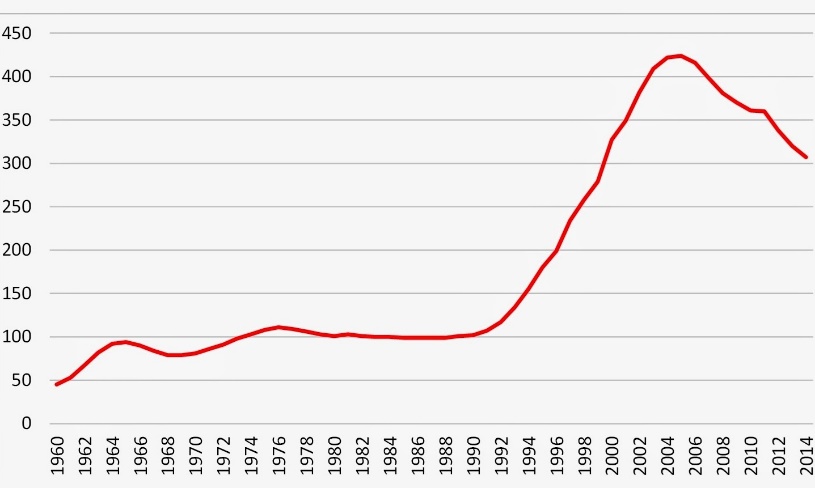
The tendency is similar in higher education as well ( KSH, 2019). Increasing the number of students was forced, and it could not be continued after it had reached a certain level. More and more students with lower abilities get admitted, and they cannot perform well, even on continuously decreasing standards ( Kori et al., 2014). The drop-out rate is very significant on all IT majors (Fig.
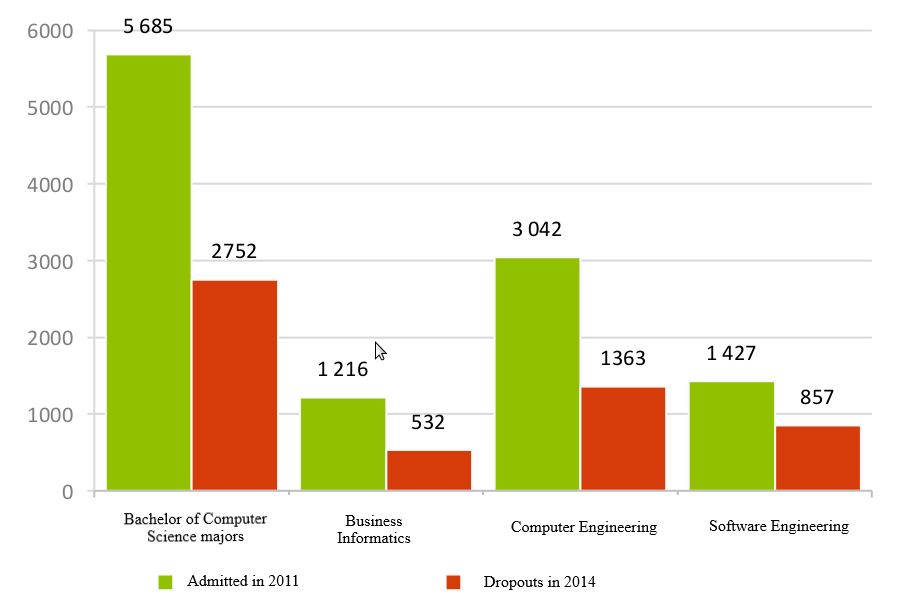
The dropout rate is high, especially in the field of Computer Science ( Bellresearch, 2015). The average student dropout rate for computer science students in Europe is at around 19% ( Hüsing et al., 2013). In Hungary, the dropout rate in ICT studies is around 48%, which is much higher than the European average. Business-informatics and computer-engineering are 44 - 45% of the dropouts, while the worst is the software engineering is 60% ( Bellresearch, 2015). ICT students dropout is also an important problem in United States ( Talton, Peterson, Kamin, Israel, & Al-Muhtadi, 2006) and in Asia ( Weng, Cheong, & Cheong 2010). One factor that may influence dropout in all disciplines is learning motivation ( Kori et al., 2016; Rumberger, 2004; Vallerand & Bissonnette, 1992).
The interesting trend to aim for admission of as many students as possible without selection has emerged for the sake of the survival of the school. They should be kept in the institution for as long as possible. Yet, as they cannot even meet the requirements in spite of the myriad of concessions made for the sake of improving retention rates, and as the school has already received normative funding for them, they let them fail before or during the final exams as a loss.
Masses of Graduates
The average rate of higher education graduates was 39.1% in the European Union in 2016. This number has emerged after 10 years of continuous rise of 10%. However, the tendency is strongly slowing down, since it has only risen 0.5 percentage point last year.
The aim of the strategy Europe 2020 was that at least 40% of people aged 30-34 should have a degree in the European Union. Eighteen member states have reached or exceeded this strategic objective. However, a slight decrease can be observed in Hungary recently, since the rate of degree owners was 32.1% in 2014, but it was 30.2% in 2017 among people aged 25-34. To reach the goals, admission requirements needed to be reduced. Admission system has changed, and threshold scores could be set based on the range of student number to be admitted. Children with lower abilities get their G.E.D. in the first place. They appear in higher education, to where they can easily get admitted. Still, Computer Science majors are in a better situation, due to the high number of applicants and the high need for IT professionals, so the universities can afford to have a higher failure rate from a financial perspective, and it has grown significantly. In 2004, the number of enrolled students began to decline. They mostly graduated in 2007. Interestingly, the drop-out rate also started to decrease from 2007 (Fig.
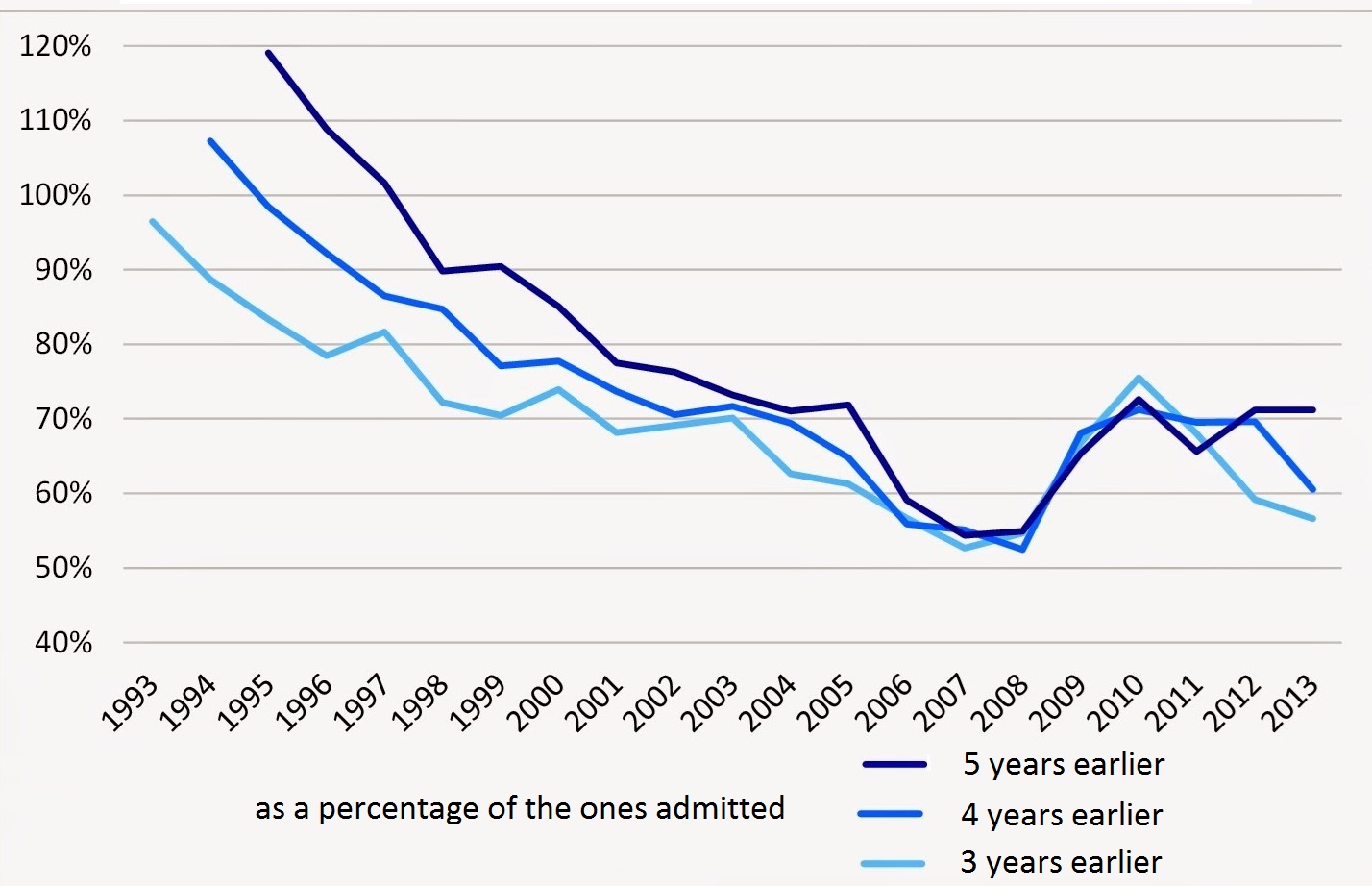
Comparison of the preceding 3 graphs above shows an interesting connection ( KSH, 2019). The number of students in higher education started to decrease around 2004. Three years later, when most of them graduated from their Bachelor’s studies, the graduation rates started to increase. The less students are admitted to universities, the higher the graduation rates, and the higher the number of admissions, the lower number of students graduate successfully. So, in case of high admission rates, more students turn out not to belong there, and become drop-outs, while as a consequence of higher admission requirements, graduation rates improve.
It is an interesting situation that vocational schools of Information Technology has less students studying further than a general high school does. However, they study programming for years in vocational schools, and it would give them great advantage at universities, where this subject has the highest failure rate ( Fishbein & Ajzen, 1975; Hagan & Markham, 2000). Based on our own measurements at a vocational school of Information Technology, most of them do not even want to stay in this field, as they consider it too difficult, and only 30% of them would like to study further (Fig.
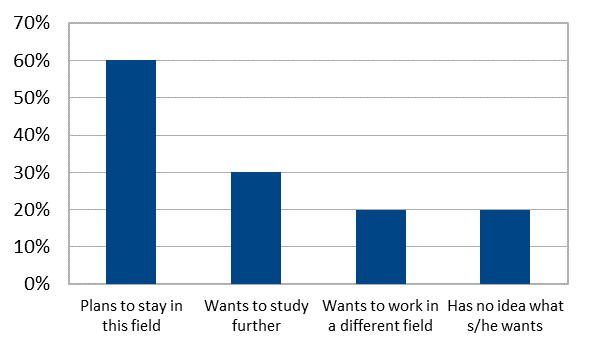
The vocational school of information technology has such high centrally defined standards, compared to the abilities of students, that if students reach them, they could fit in among undergraduate sophomores. And there is still another level of education between the two educational institutions: the so-called post-secondary vocational education, which is taught by universities, but only offers a certificate of graduation instead of a degree.
We had the students take the same test of Web-programming at the vocational school (software engineering training after high school) as the one at the university (Bachelor of Computer Engineering). Secondary school students had studied programming for one semester, and Web-programming for another. Undergraduate students had studied programming for 3 semesters, and Web-programming also for one. The difference was surprisingly low (Fig.
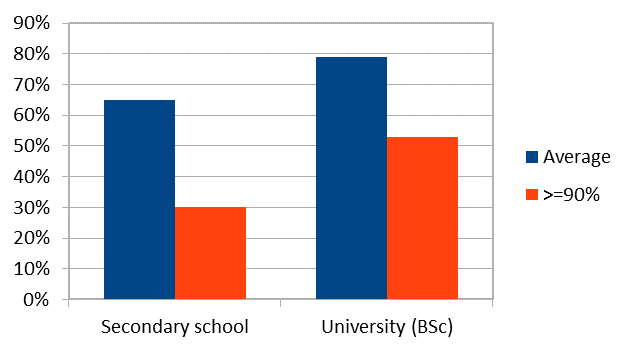
Secondary school students had results of 65% on average, while university students had 79%. The rate of results 90% or over was 30% at the secondary school, while it was 53% at the university. The age, and the gender rate was approximately the same. Considering that Bachelor’s is a two level higher education, we had expected greater difference.
So, the expectations centrally defined for vocational schools are disproportionately high, but it does not increase the students' knowledge. Yet, they show worse and worse performance every year, as a matter of fact. So, we consider the educational policy attempting to improve standards of education with continuously growing expectations a mistake.
Research Questions
-
What are the consequences of mass education?
-
What are the consequences of the quality-corruptive effect of financing, and unfitting students solely kept for the sake of school maintenance?
-
Do we need masses of bad professionals with a university degree?
-
What is the degree of willingness to study further in their own field among vocational school students?
-
Can we motivate students, and make them more devoted to their field by developing and applying innovative educational technologies? Can we decrease dropout rates?
Purpose of the Study
We aim to review the possible causes of the educational crisis: errors of capitation schemes versus the normative system; quality-corruptive effect of overissuance of degrees and keeping unfitting students in the system at all costs. We see the lack of motivation among students. We examine the effects of too much requirements in vocational schools. We examine the extremely low rate of specialised further education at universities. We were wondering how much more talented the students are at universities than in secondary education. In the end, we attempted to reach better learning outcomes and dedication of students groups at both secondary and higher education with the help of practical, motivation enhancing educational technologies.
Research Methods
We began our work with processing of public statistical data. We carried out our own surveys (questionnaire, interview, comparative professional tests) in a vocational school and at the university. We developed practical technologies, which we tested and evaluated on both educational levels.
Findings
Educational technologies through practical tasks
Due to the lack of professionals on the labor market, and the students' low performance and high dropout rates, we need as effective educational technologies as possible in teaching information technology. It is getting more and more difficult to cross the bar of stimulus of the current generation; to keep their interest is a great challenge. It is a known fact that dry, lexical information transfer has visibly lower results than education through practical tasks. Experience from own mistakes is even more effective, based on our experience. Raising and keeping students' interest is becoming a greater challenge on every level of education. We attempt to search for innovative educational solutions that will lead to results on both secondary, and post-secondary levels.
Destroy it
In computer engineering and software engineering education, it is essential to program controls and sensors. Personal Computers no longer have direct, binary-controlled I/O ports, like the old parallel port. So a USB port needs to be used for communication with external devices. Still, USB provides serial data transfer, and not direct control, so we install micro-controllers between the devices. Yet, it requires using complex, sensitive and occasionally expensive devices.
The 5V TTL signal level of the micro-controller needs to be adjusted to the external device (Fig.
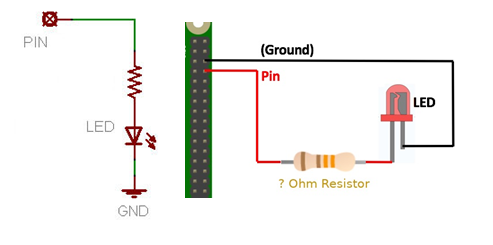
In the high school we studied, 35% of students are not able to apply Ohm’s law during LED controlling at the end of the two-year long vocational training of information technology. 16% of undergraduate Computer Engineering seniors showed the same results. Both findings are extremely disappointing. This theoretical curriculum is on the elementary school level, but it does not even turn into a practical skill of an alarming number of students at graduation. Supposedly, the anomaly is not caused by the lack of lexical knowledge, but rather the inadequacy of direct experience. So, they partly remember something, but they cannot apply their knowledge.
As an experimental, innovative solution, we add strong emotional effect to practical experiences for the sake of enhancing teaching efficiency. We should let them possibly destroy the entire circuit. Before students connect a more valuable hardware to the micro-controllers, they should experience the consequences of faulty scaling. We should make them feel responsible by providing cheap devices. The price of LED is low, but it can be visibly destroyed by the usage of wrongly scaled resistance. In case of over-scaling, its light emission will be insufficient (Fig.
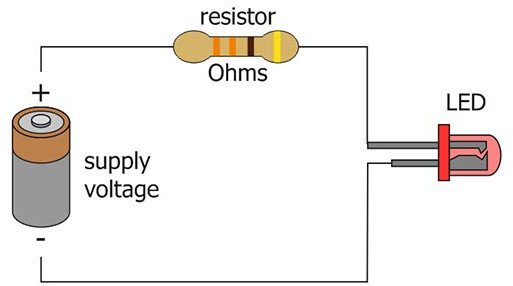
For electric power supply, it is practical to use a transformer naturally protected against excess current for the sake of preventing overheating caused by a short circuit or the explosion of the batteries. The above example is just a simple, initial one. Continuing it would help with teaching more and more complicated circuit solutions in a similar way (E.g.: solid-state amplifiers, operational amplifiers, optocoupler, data transmission or sensor switching etc.). The method is capable of increasing learning effectiveness by 60%, which can be considered extremely good. With this technology, the costs of education do not rise significantly, although this type of curriculum takes more work to elaborate.
Team work as part of a grandiose project
While students are learning how to control movements, they first drive an analog engine. Then they use a step motor, and power steering engines after that. It is a challenge for students of both secondary schools and universities, to drive several engines in accordance. Participation in a huge, common project inspires students to a great extent. They work on a task together. They need to share both successes and failures. They learn to cooperate and work in a team. Solving parts of a huge task is the most fit to this. It should be a project that raises interest and leads to an impressive result. We gave them the task to build a humanoid robot. We can find plenty of finished samples on the Internet, which provides strong motivation. An essential condition for motivation is better learning outcomes ( Kleinginna & Kleinginna, 1981; Bruinsma, 2004), and reduced dropout rates ( Gottfried, 2009).
The task covers the knowledge of several fields. Students can choose from the sub-tasks the most interesting to them: anything from planning the mechanical frame of the robot, through scaling power supply, controlling decentralized micro-controllers and reading sensors, or creating internal data transfer, to writing AI software of the central computer (the brain). So, there are operations from lower and higher levels as well. It provides an opportunity to differentiate, to choose the task the most suitable to their talent and interest. They reach better results at tasks that are closer to them, and the feeling of success inspires them. The sub-task needs to be connected to the great project, so cooperation is essential. Close cooperation is needed not only within the team, but also among teams. An essential part of preparation for the job market is the ability to work together, to gain cooperation skills.
The task of a student team planning the frame and design of a robot is innovative, for instance (Fig.
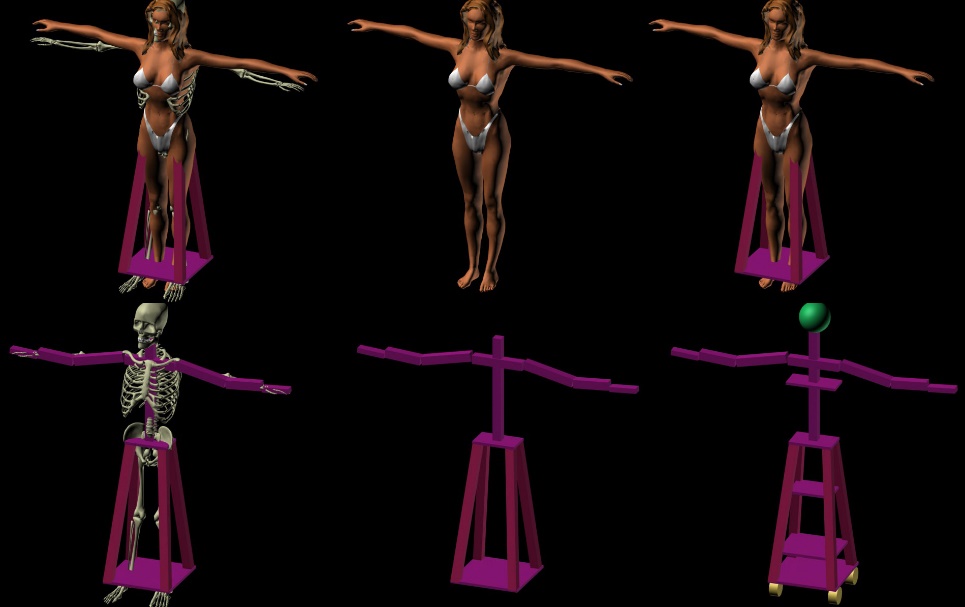
Another team realizes the movement of fingers of the hand. The hand will be moved by an arm realized by another team. Cooperation between the two teams is essential.
They build a testing system first, to move the fingers of the hand. Power steering engine is controlled by analog potentiometers. After this, they make the solution of the task more complex and smoother step by step (Fig.
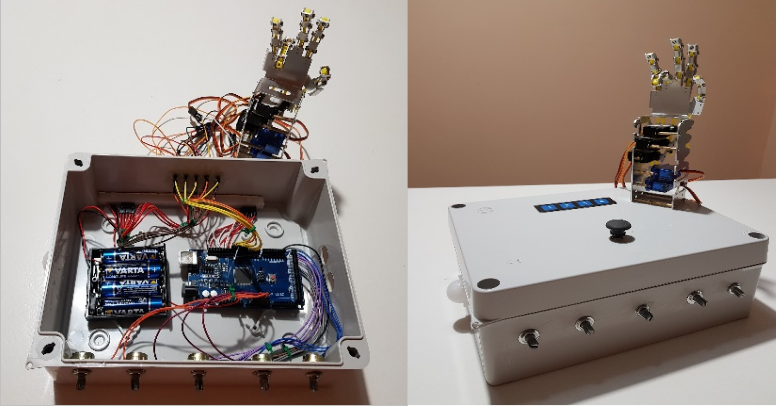
The humanoid robot is usually not completely finished. Yet, on the road towards completion, extremely effective educational efficiency can be achieved. The willingness to participate in tasks is usually around 70% in cases of traditional tasks, while it is almost 100% in case of “building the great task together.” So we can raise the interest of the rest, the inactive 30%, and they can participate in the common task. To perform the task, the students need theoretical knowledge, which they previously disliked, because they now see its practical benefits. They also admit that they cannot effectively cooperate with their mates within the team without theoretical knowledge. This feeling is unpleasant to them, so they experience knowledge as a glory in the eyes of their classmates with this methodology, and it is very inspiring.
Since the authors participate in both secondary and higher education, we serve as a sort of bridge between the two levels of education. As a consequence of applying the similar, innovative education technology, more students decide to study further. They see that they can prove themselves at such tasks, and they trust themselves that they can continue this on a higher level at the university.
Conclusion
Making the curriculum more difficult does not provide greater knowledge to students. Less curriculum should therefore be covered more deeply, and the exams should be more thorough. The pace of teaching should be slower, but knowledge itself should be solid.
Compliance with the requirements should be more strict as early as in secondary education. Students who do not want to learn should not pass. If the number of students did not affect the financial situation of the school, students with low performance should not be kept at all costs. Staying at school would be valuable again for students. The danger of dropping out without a profession would motivate parents to monitor and improve their children’s educational achievements. Capitation-based financing of schools is an extremely erroneous educational policy.
Similarly, the highest possible rate of degree holders should not be artificially set. Those who do not belong to the university, should not be given a degree. The value of a degree should be sustained by sustaining standards.
This is exactly why innovative educational technologies bears a great significance in the field of IT education. Effective methods can soften the harmful consequences of the effects of erroneous education politics, and they can help raising the standards of education. So, we found the self elaborated methods of “destroy it and learn from your mistakes” and “create something grandiose in a team” highly effective.
We hold it extremely important at secondary schools of information technology to raise and inspire the talented minority, who would otherwise not study further. Since they have studied IT on a secondary level, these students could become the best professionals, if we could boost their self-confidence sufficiently enough to study further.
Acknowledgments
We would like to express our special thanks of gratitude to Beregszászi Pál Secondary School (Nagyné Oláh Katalin director) of the Debrecen SZC (Hámori Éva Judit and Tirpák Zsolt directors), where we have performed a part of our examinations. EFOP-3.6.3-VEKOP-16-2017-00002 “Integrált kutatói utánpótlásképzési program az informatika és számítástudomány diszciplináris területein”. Tender of the Research Teacher (ENIC/NARIC Hungary, Educational Authority) of Debrecen SZC Beregszászi Pál Gymnasium and Secondary Technical School and Comenius Campus of Eszterházy Károly University, Sárospatak
References
- Bellresearch (2015). Examination of the Situation, Problems and Barriers of Hungarian Education of Information Technology and Engineering, 2015, Executive Summary. Bellresearch. Retrieved from www.bellresearch.com
- Bruinsma, M. (2004). Motivation, cognitive processing and achievement in higher education. Learning and Instruction, 14(6), 549-568.
- Fishbein, M., & Ajzen, I. (1975). Belief, Attitude, Intention and Behavior: An Introduction to Theory and Research, Reading. MA: Addison-Wesley.
- Gottfried, A. E. (2009). Commentary: The role of environment in contextual and social influences on motivation: Generalities, specificities and causality. In K. R. Wentzel & A. Wigfield (Eds.), Handbook of Motivation at School (pp. 462-475). New York: Routledge.
- Hagan, H., & Markham, S. (2000). Does it help to have some programming experience before beginning a computing degree program? In Proc. the 5th Annual SIGCSE/SIGCUE ITiCSE Conference on Innovation and Technology in Computer Science Education, 2000, 25-28.
- Hüsing, T., Korte, W. B., Fonstad, N., Lanvin, B., Cattaneo, G., Kolding, M., … & van Welsum, D. (2013). E-leadership, e-skills for competitiveness and innovation vision, roadmap and foresight scenarios final report. [Online]. Retrieved from http://ec.europa.eu/enterprise/sectors/ict/files/eskills/vision_final_rep ort_en.pdf
- Karsten, G., Hüsing, T., Birov, S., Bludova, I., Schulz, C., & Korte, W. B. (2014). eSkills for Jobs in Europe: Measuring progress and moving ahead, Final report. Empirica Gesellschaft für Kommunikations- und Technologieforschung mbH.
- Kleinginna, P., & Kleinginna, A. (1981). A categorized list of motivation definitions, with suggestions for a consensual definition. Motivation and Emotion, 5(4), 263-291.
- Kori, K., Pedaste, M., Niitsoo, M., Kuusik, R., Altin, H., Tõnisson, E., … & Paluoja, R. (2014). Why do students choose to study information and communications technology? Procedia - Social and Behavioral Sciences, 191, 2867-2872. https://doi.org/10.1016/j.sbspro.2015.04.249
- Kori, K., Pedaste, M., Leijen, A., & Tõnisson, E. (2016). The Role of Programming Experience in ICT Students’ Learning Motivation and Academic Achievement. International Journal of Information and Education Technology, 6(5). https://doi.org/10.7763/IJIET.2016.V6.709
- KSH (2019). Retrieved from https://www.ksh.hu/
- Rumberger, R. W (2004). Why students drop out of school. In G. Orfield (Ed.), Dropouts in America: Confronting the Graduation Rate Crisis (pp. 131-155). Cambridge, MA: Harvard Education Press.
- Talton, J. O., Peterson, D. L., Kamin, S., Israel, D., & Al-Muhtadi, J. (2006). Scavenger hunt: Computer science retention through orientation. Proc. the 37th SIGCSE Technical Symposium on Computer Science Education, 443–447.
- Vallerand, R. G., & Bissonnette, R. (1992). On the predictive effect of intrinsic, extrinsic, and amotivation styles on behaviour: A prospective study. Journal of Personality, 60, 599-620.
- Weng, F., Cheong, F., & Cheong, C. (2010). The combined effect of self-efficacy and academic integration on higher education students studying IT majors in Taiwan. Education and Information Technologies, 15, 333-353.
Copyright information

This work is licensed under a Creative Commons Attribution-NonCommercial-NoDerivatives 4.0 International License.
About this article
Publication Date
17 June 2020
Article Doi
eBook ISBN
978-1-80296-084-6
Publisher
European Publisher
Volume
85
Print ISBN (optional)
-
Edition Number
1st Edition
Pages
1-814
Subjects
Teacher, teacher training, teaching skills, teaching techniques, special education, children with special needs
Cite this article as:
Godó, Z. A., Hódi, Z., Borsos, B., Stóka, G., & Kiss, G. (2020). Need For Motivating Educational Technologies At Teaching Computer Science. In V. Chis (Ed.), Education, Reflection, Development – ERD 2019, vol 85. European Proceedings of Social and Behavioural Sciences (pp. 410-422). European Publisher. https://doi.org/10.15405/epsbs.2020.06.41
